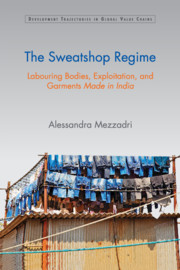Book contents
- Frontmatter
- Dedication
- Contents
- List of Tables, Figures and Pictures
- Acknowledgements
- List of Abbreviations
- Introduction
- 1 The Chain and the Sweatshop
- 2 The Commodity and the Sweatshop
- 3 Difference and the Sweatshop
- 4 The Regional Lord and the Sweatshop
- 5 The Broker and the Sweatshop
- 6 The Body and the Sweatshop
- Conclusions
- References
- Index
3 - Difference and the Sweatshop
Published online by Cambridge University Press: 23 July 2017
- Frontmatter
- Dedication
- Contents
- List of Tables, Figures and Pictures
- Acknowledgements
- List of Abbreviations
- Introduction
- 1 The Chain and the Sweatshop
- 2 The Commodity and the Sweatshop
- 3 Difference and the Sweatshop
- 4 The Regional Lord and the Sweatshop
- 5 The Broker and the Sweatshop
- 6 The Body and the Sweatshop
- Conclusions
- References
- Index
Summary
The nature of capitalism is not to create a homogeneous social and economic system, but rather to dominate and to draw profit from the diversity and inequality that remain in permanence.
(Berger, 1980, p. 136)Difference before and within Labour
The sweatshop appears as a world of stark differences. It is made of multiple spaces of work whose composite social architecture varies with the physical materiality of the commodities produced. It is inhabited by different typologies of workers who may be subject to the wage relation either directly or indirectly, according to different degrees of ‘freedom’ from means of production and subsistence. These workers are subject to differential processes of proletarianization. In fact, capital fragments and segments the workforce through multiple boundary-drawing strategies (Silver, 2003); it extracts labour surplus in multiple ways (Banaji, 2003) and it also generates multiple labour outcomes (Bernstein, 2007). However, is ‘difference’ produced by capital or does it pre-exist capital? This is a crucial question, when it comes to analyzing the complex world of the sweatshop. In rather crude terms, in accounts stressing difference as primarily produced by capital, ‘exploitation’ emerges as the key process subjugating labour inside the sweatshop. In accounts stressing instead difference as pre-existing capital, emphasis is primarily placed on processes of labour ‘commodification’. The way in which ‘difference’ and ‘capital’ articulate (Tsing, 2009; Bair, 2010) is hardly a theoretical conundrum. Rather, it is also of utmost importance for political reflection, in a time and age when the income share accruing to labourers worldwide (and not only in sweatshops!) has ruinously fallen, and inequality massively risen to benefit what the Occupy movement (and now renowned inequality scholars, like Thomas Piketty) identified as the infamous ‘1 per cent’.
A debate counterpoising ‘exploitation’ and ‘commodification’ is currently reaching momentum (see for instance, Selwyn and Miyamura, 2014), despite being hardly a novel debate. For instance, by the 1970s, this debate (amongst others) impacted significantly the ‘unhappy marriage of Marxism and Feminism’ (Hartmann, 1979; see also Molyneux, 1979, and Vogel, 1983).
- Type
- Chapter
- Information
- The Sweatshop RegimeLabouring Bodies, Exploitation and Garments <I>Made in India</I>, pp. 73 - 103Publisher: Cambridge University PressPrint publication year: 2016



